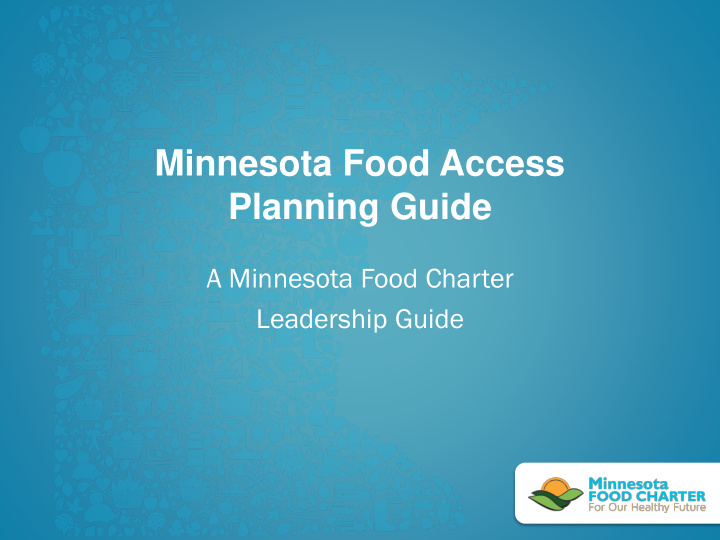



Minnesota Food Access Planning Guide A Minnesota Food Charter Leadership Guide
Food Access Presentation
Introductions • Liz Heyman, planner, City of Bloomington
The Need • Changing food system. • Changing demographics, economy, and development trends. • Knowledge gap between food and planning. • Comprehensive planning process in the metro. • A need to focus on equity.
Purpose • Bridge the Knowledge gap between planners and food systems advocates by providing an overview of the food system and planning • Provide tools and language to facilitate policy, systems, and environmental change. • Empower planners • Empower food systems advocates
Food Access Planning Guide • Part I. provides an overview of both food and planning issues by highlighting important background information, legal/law considerations and impacts, and trend information. • Part II. provide model comprehensive plan language as a resource to ease the process of adoption and implementation of food policy and E changes for local and regional governments and agencies
Strategy Areas • Land Use • Housing • Transportation • Economic Development • Farmland Preservation • Food Production • Food Aggregation + Processing + Distribution • Healthy Food Retail • Pollinators
Strategy Areas • Goal Statement • Overview • Policy & Strategy Recommendations • Things to Consider • Case Studies • Additional Resources
Strategy Area Example: Healthy Retail • Goal Statement: Expand reliable access to food retail options that offer safe, affordable, healthy food. – Policy I: [Local government] will partner in efforts to bring a new grocery store to the community/underserved location. • Contribute to the research needed for establishing realistic expectations and an appropriate strategy. • Modify zoning codes that may restrict or not permit grocery stores, particularly in neighborhood commercial districts near residential uses.
Strategy Area Example: Healthy Retail • Things to Consider: – Strong partnerships between local government and other stakeholders and advocates are important for bringing needed energy to the complex issues of attracting a grocery store – Because of its many benefits to the public, the development of a grocery store can justify public financial support, but only where the store will generate sufficient sales to cover operating expenses.
Thank you • Eric Weiss, AICP, Center for Prevention at Blue Cross Blue Shield of Minnesota eric.weiss@bluecrossmn.com 651-662-4505 • Sign up to receive updates on the guide at: http://mnfoodcharter.com/or der-for-minnesota-food-charter- comp-planners-guide/
Recommend
More recommend